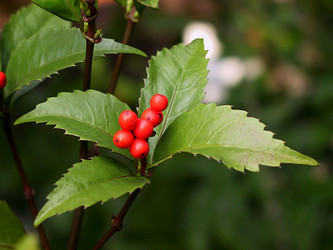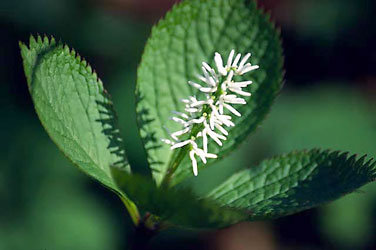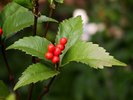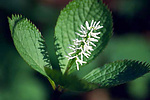Chloranthaceae



This tree diagram shows the relationships between several groups of organisms.
The root of the current tree connects the organisms featured in this tree to their containing group and the rest of the Tree of Life. The basal branching point in the tree represents the ancestor of the other groups in the tree. This ancestor diversified over time into several descendent subgroups, which are represented as internal nodes and terminal taxa to the right.

You can click on the root to travel down the Tree of Life all the way to the root of all Life, and you can click on the names of descendent subgroups to travel up the Tree of Life all the way to individual species.
For more information on ToL tree formatting, please see Interpreting the Tree or Classification. To learn more about phylogenetic trees, please visit our Phylogenetic Biology pages.
close boxReferences
Carlquist, S. 1987. Presence of vessels in wood of Sarcandra (Chloranthaceae): comments on vessel origins in angiosperms. American Journal of Botany 74:1765-1771.
Carlquist, S. 1992. Wood anatomy and stem of Chloranthus: summary of wood anatomy of Chloranthaceae, with comments on relationships, vessellessness, and the origin of Monocotyledons. IAWA Bulletin II 13:3-16
Crane, P. R., E. M. Friis, and K. R. Pedersen. 1989. Reproductive structure and function in Cretaceous Chloranthaceae. Plant Systematics & Evolution 156:211-226.
Doyle, J. A., H. Eklund, and P. S. Herendeen. 2003. Floral evolution in Chloranthaceae: Implications of a morphological phylogenetic analysis. International Journal of Plant Sciences 164 (5):S365-S382.
Eklund, H., J. A. Doyle, and P. S. Herendeen. 2004. Morphological phylogenetic analysis of living and fossil Chloranthaceae. International Journal of Plant Sciences 165 (1): 107-151.
Eklund, H., E. M. Friis, and K. R. Pedersen. 1997. Chloranthaceous floral structures from the Late Cretaceous of Sweden. Plant Systematics and Evolution 207:13-42.
Endress, P. K. 1987. The Chloranthaceae: reproductive structures and phylogenetic position. Botanische Jahrbücher Systematik 109:153-226.
Endress, P. K. 2001. The flowers in extant basal angiosperms and inferences on ancestral flowers. International Journal of Plant Sciences 162:1111-1140.
Friis, E. M., P. R. Crane, and K. R. Pedersen. 1986. Floral evidence for Cretaceous chloranthoid angiosperms. Nature 320:163-164.
Kong, H. Z. 2000. Karyotypes of Sarcandra Gardn. and Chloranthus Swartz (Chloranthaceae) from China. Botanical Journal of the Linnean Society 133:327-342.
Kong, H. Z. 2001. Comparative morphology of leaf epidermis in the Chloranthaceae. Botanical Journal of the Linnean Society 136:279-294.
Kong, H. Z., A. M. Lu, and P. K. Endress. 2002. Floral organogenesis of Chloranthus sessilifolius, with special emphasis on the morphological nature of the androecium of Chloranthus (Chloranthaceae). Plant Systematics and Evolution 232:181-188.
Okada, H. 1995. Karyological studies of four genera of the Chloranthaceae. Plant Systematics & Evolution 195:177-185.
Qiu, Y. L., J. H. Lee, F. Bernasconi-Quadroni, D. E. Soltis, P. S. Soltis, M. Zanis, E. A. Zimmer, Z. D. Chen, V. Savolainen, and M. W. Chase. 2000. Phylogeny of basal angiosperms: Analyses of five genes from three genomes. International Journal of Plant Sciences 161:S3-S27.
Savolainen, V., M. W. Chase, S. B. Hoot, C. M. Morton, D. E. Soltis, C. Bayer, M. F. Fay, A. Y. De Bruijn, S. Sullivan, and Y. L. Qiu. 2000. Phylogenetics of flowering plants based on combined analysis of plastid atpB and rbcL gene sequences. Systematic Biology 49:306-362.
Soltis, D. E., P. S. Soltis, M. W. Chase, M. E. Mort, D. C. Albach, M. Zanis, V. Savolainen, W. H. Hahn, S. B. Hoot, M. F. Fay, M. Axtell, S. M. Swensen, L. M. Prince, W. J. Kress, K. C. Nixon, and J. S. Farris. 2000. Angiosperm phylogeny inferred from 18S rDNA, rbcL, and atpB sequences. Botanical Journal of the Linnean Society 133:381-461.
Todzia, C. A. 1993. Chloranthaceae. Pages 197-200 in The Families and Genera of Vascular Plants. 2. Flowering Plants, Dicotyledons: Magnoliid, Hamamelid, and Caryophyllid Families. K. Kubitzki, J. G. Rohwer, and V. Bittrich, eds. New York: Springer.
Todzia, C. A. and R. C. Keating. 1991. Leaf architecture of Chloranthaceae. Annals of the Missouri Botanical Garden 78:476-496.
von Balthazar, M. and P. K. Endress. 1999. Floral bract function, flowering process and breeding systems of Sarcandra and Chloranthus (Chloranthaceae). Plant Systematics and Evolution 218:161-178.
Yamada, T., H. Tobe, R. Imaichi, and M. Kato. 2001. Developmental morphology of the ovules of Amborella trichopoda (Amborellaceae) and Chloranthus serratus (Chloranthaceae). Botanical Journal of the Linnean Society 137:277-290.
Zhang, L. B. and S. Renner. 2003. The deepest splits in Chloranthaceae as resolved by chloroplast sequences. International Journal of Plant Sciences 164 (5):S383-S392.
Information on the Internet
Deep Time Project: ChloranthaceaeTitle Illustrations

| Scientific Name | Sarcandra glabra |
|---|---|
| Specimen Condition | Live Specimen |
| Body Part | fruits |
| Source | Sarcandra glabra |
| Source Collection | Flickr |
| Image Use |
 This media file is licensed under the Creative Commons Attribution License - Version 2.0. This media file is licensed under the Creative Commons Attribution License - Version 2.0.
|
| Copyright | © 2004 Juni A. |
| Scientific Name | Chloranthus japonicus |
|---|---|
| Location | Vityaz inlet, Gamov Peninsula, Khasansky distr., Primorsky Territory (Russian Federation) |
| Source Collection | CalPhotos |
| Copyright |
© 2001

|
About This Page
Page copyright © 2002
All Rights Reserved.
Citing this page:
Tree of Life Web Project. 2002. Chloranthaceae. Version 01 January 2002 (temporary). http://tolweb.org/Chloranthaceae/20669/2002.01.01 in The Tree of Life Web Project, http://tolweb.org/









 Go to quick links
Go to quick search
Go to navigation for this section of the ToL site
Go to detailed links for the ToL site
Go to quick links
Go to quick search
Go to navigation for this section of the ToL site
Go to detailed links for the ToL site